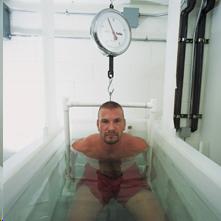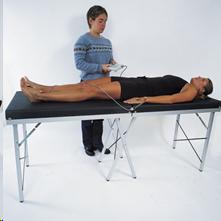
Measuring Body Composition (2 of 2)


Two other ways that we measure body composition are underwater weighing and bioelectrical impedance. Underwater weighing, which we also know as hydrostatic weighing, is based on Archimedes principle, and that is when a body is submerged in water, there's a buoyant counterforce equal to the weight of the water that's displaced. So, someone with lean muscle and bone, with a lot of lean muscle and bone, will be denser because those tissues are denser than water. So a person with lots of those types of tissues will weigh more in the water than someone who has the same weight on land but a higher percentage of fat in their body. And you can also think of this as fat floats, muscle and bone are denser than water, so a person with lots of those tissues is going to weigh more in the water. The person who weighs more in the water has a lower body fat percentage. So that's the first type.
The second type of way that we measure body composition is bioelectrical impedance, and here we're using a low level electrical current that's sent through the body, and then the resistance to that current by the tissues is then measured. And since lean tissue has more water than fat, it conducts the signal faster than fat. And this test is quick and painless to the participant. The electrical current is not strong enough to cause any problems. So it's quick and painless. The error rate is about three percent. So if someone's body fat composition is measured at 20 percent, their actual body composition is likely to fall somewhere between 17 and 23. And this error is a little bit higher than the 1.5 percent error rate of underwater weighing.
It's also important to note that these are not the only three ways, including skinfold testing, underwater weighing, and bioelectrical impedance. These are not the only ways to measure body composition. We can also do it through x-ray (such as the DEXA machine); air density (oftentimes the Bod Pod it's called) is used. So there are many other ways of measuring body composition, but these are just three that we'll highlight here.